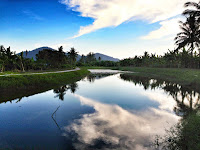Lung-Washing the Malaysian Way
 |
| Malaysia is a photographer's dream playground. There's a good shot everywhere. This photo was taken at Balik Pulau, the other side of busy Georgetown, Penang. |
‘Lung-Washing’ is a medical procedure in which the lungs are literally washed out with a saline solution – about 30 litres of it. The process allows people who have had difficulty in breathing – in some cases for many years – to breathe normally again. The breathing difficulty has the technical name of Pulmonary Alveolar Proteinosis, shortened to PAP. It is characterized by the accumulation of protein and lipid material, called surfactant, within the lung air sacs or alveoli. The alveoli absorb oxygen from the air into the blood. To do this, the alveoli are lined with surfactant. Surfactant serves to keep air sacs open to capture oxygen so that the blood can transport it from the lungs to the rest of the body.
The process of lung-washing is not new. It has been around for many years, though recent technological breakthroughs have made its diagnosis easier through the use of bronchoscopy, where a tube with a microscopic camera in the end is inserted through the nose and down the throat to the lungs to allow full examination of their condition. Another recent breakthrough is the capacity to wash both lungs at once.
So lung-washing in Malaysia will be in the domain of medical tourism, right? Wrong!
Lung washing in Malaysia will be more in the area of eco-tourism and is aimed to encourage tourists from cities which suffer from serious air pollution – and there are many of them – to visit Malaysia to give their lungs a chance to breathe clean air for a while. It is an interesting initiative resulting from the application of the Blue Ocean Strategy recently espoused by the Malaysian government.
It is an interesting concept, though research will be needed to see how long an exposure to clean air will be needed to actually reverse the problems caused by continuously breathing polluted air in the tourists’ home country. It would also mean that the capital Kuala Lumpur may not be on the itinerary, since it has some air pollution problems of its own. Nor would the tourists gain much respite during the period that areas that normally have clean air are covered in unwanted haze from Indonesia.
Using clean air as a tourist attraction is not really a new concept – New Zealand has been using it for years. But clean air is a factor which may persuade people to come to the more pristine areas of Malaysia.


Comments
Post a Comment